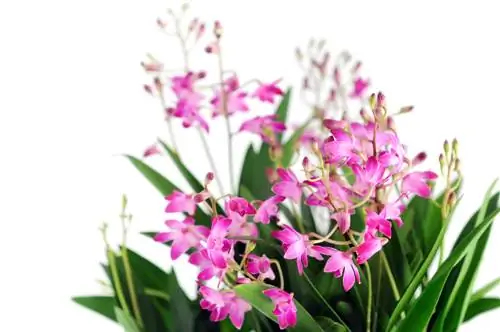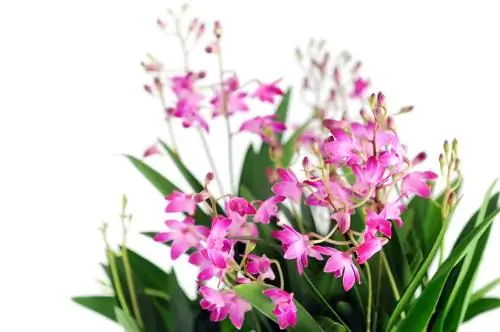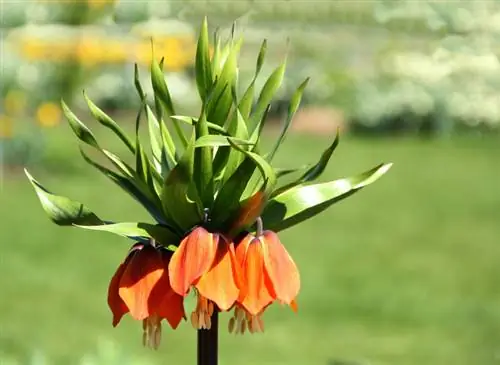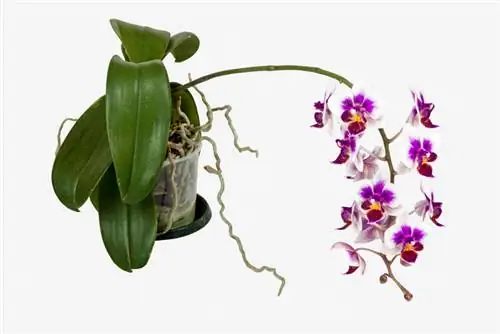- Author admin [email protected].
- Public 2024-01-10 23:11.
- Last modified 2025-06-01 06:02.
Dendrobiums are among the most lushly flowering ornamental orchids. With us they are great to keep on the windowsill. We have put together everything you need to consider when cultivating and caring for it.

How to properly care for a Dendrobium orchid?
Dendrobium orchids are popular ornamental plants from Southeast Asia with lush flowers and diverse species. Care includes a bright location without direct sun, moderate watering with low-lime water, a loose bark substrate and a cool winter at 10-17°C for flower formation.
Origin
Dendrobiums belong to the orchid plant family and are very diverse with around 1,600 different species. Like most orchids, dendrobiums originally come primarily from tropical habitats in Southeast Asia from India to the Philippines, Australia and New Zealand. However, some species have also adapted to dry, cooler regions, such as the high altitudes of the Himalayas or the interior of Australia.
The species that are preferred to be cultivated as ornamental plants in Central Europe are primarily hybrid species such as the grape orchid Dendrobium nobile or the Dendrobium bigibbum. These species are ideal for home windowsill cultivation with cool overwintering.
Growth
Typically, most dendrobium species are epiphytes - meaning that in their original areas of origin they grow preferably on trees, and occasionally also on rocks. They hold on to their host plant - or in the container to the substrate - with numerous aerial roots and, depending on the species, grow only a few centimeters or up to a meter high. The grape orchid Dendrobium nobile reaches around 30 to 45 centimeters.
Dendrobiums also belong to the sympodial orchids that form so-called pseudobulbs. These club or spindle-like shoot axes serve as water and nutrient storage for the plant
To remember:
- Dendrobiums are epiphytes - so they originally grow on trees
- Hybrids cultivated here are about 30-45 cm high
- form sympodial pseudobulbs for nutrient and water storage
leaves
The leaves of dendrobiums usually have a typically orchid-like, oval to lanceolate shape and a leathery, fleshy consistency. They attach alternately on the stem and are medium green in color. At the end of the growing season the leaves are shed.
Flowers
The most important part of dendrobiums for the ornamental gardener is of course the flower. This is particularly rich in this type of orchid. The many individual flowers unfold both on the sides and at the ends of the two-year-old, leafless pseudobulbs, resulting in a whole, panicle-like flower stalk. They sit on short stems in the leaf axils. In terms of morphology, the dendrobium flowers vary depending on the species, but are usually typical of orchids with three sepals, two petals and a lip-shaped sixth petal.
A Dendrobium orchid can produce around 20 to 50 individual flowers, which often have a very pleasant scent.
The flower characteristics at a glance:
- Appear in large numbers completely along the previous year's pseudobulbs
- forms a lush panicle
- Morphology of the individual flowers orchid-like
- often very pleasant scent
When is flowering time?
The lush flowers of the Dendrobium orchid occur in the growing season between spring and autumn. If the ambient temperature is not too warm, the flowers last a pleasantly long time, around 3 to 6 weeks.
Which location is suitable?
Dendrobiums need a bright location, but should not be exposed to direct sunlight. You can also put it outside in summer, but ideally under a light roof on the terrace or balcony. The denrdobia orchid should be bright even in winter.
However, the temperature requires a seasonal change. Over the summer the plant should be kept warm, preferably from 20°C upwards. During the winter rest period, cooling is necessary, not only because of the vegetative break, but also so that the change to warm temperatures again in spring induces abundant flowering. The temperature in the winter quarters should be between around 10 and 17°C.
The location requirements in key words:
- warm and bright in summer
- cool and bright in winter
- protect from direct sunlight
What soil does the plant need?
As an epiphyte, the Dendrobium orchid prefers a loose bark substrate to which it can hold on with its aerial roots and which ensures it has enough air and light. But you can also place them in a substrate made of orchid soil. However, you should definitely incorporate an effective drainage layer and ensure good drainage, for example by placing a convex clay shard over the bottom hole in the pot. To ensure that new shoots have room to grow, it is best to place the orchid in the pot so that the older shoots are on the outside.
Repotting
Only repot a Dendrobium orchid if it is absolutely necessary, that is, if it is visibly too cramped in the pot or the substrate is simply too old and starting to look too modern. In general, the plant copes very well with cramped conditions at its base. Accordingly, do not choose a significantly larger pot for moving. The right time for repotting is spring, when the orchid forms new pseudobulbs. But repotting is also possible until autumn. In winter you should leave the plant alone.read more
Watering dendrobium
You should water the Dendrobium orchid daily from spring until the pseudobulbs have fully formed. However, be careful not to give too much water at once so that the substrate can dry out completely in between. If there is too much water, the aerial roots can easily rot, the bulbs die and the leaves are shed.
Use water that is as low in lime as possible, possibly from the rain barrel. When the pseudobulbs are mature, they can fully perform their water storage role, so you no longer necessarily need to water as often.
As a tropical plant, the Dendrobium orchid also likes the occasional fine mist spray.
The casting practice at a glance
- water daily from spring onwards during the bulb formation phase
- Pay careful attention to the measurements - always allow the substrate to dry between waterings
- be sure to use low-lime water
Fertilize Dendrobium properly
You can fertilize the Dendrobium orchid moderately during the vegetation phase. You should keep intervals of around two to three weeks - the nutrient requirements of dendrobiums are rather low. Use a low concentration liquid fertilizer. Starting in the fall, you should taper off fertilizing - in the winter, fertilize very sparingly, if at all.
Cutting dendrobium correctly
Pruning is not necessary for dendrobiums. You don't need to cut off old leaves yourself; they fall off on their own or can be carefully plucked off. If it bothers you, you can remove an old, dead shoot with scissors.read more
Propagate Dendrobium
Kindel
Dendrobiums are child-producing plants - this practically answers the question of the propagation method. The kindles form on the shoot eyes of the pseudobulbs, and occasionally also on the stems of the flowers. You should let the children grow on the mother plant for as long as possible so that they can accumulate enough strength of their own and develop roots about 5 cm long. It's best to let it mature for a whole year. The condition of the bulb also indicates that detachment and an independent life for the child are possible: If it turns yellow and begins to dry out, it has fulfilled its task and the child is mature.
However, you should only separate it from the mother plant if it is easy to do so. To do this, try turning it carefully. If the child does not come off easily, cut it off along with a piece of bulb and place it in its own planter with orchid soil.
It often takes about a year before the young plant shows its first flower.
Division
Dendrobiums can also be propagated by rhizome division. However, child propagation is preferable to this method. If you cut off a piece of the rhizome, make sure that the section has at least 4 pseudobulbs. Place the section in a planter with orchid soil and keep it evenly but sparingly moist. After sprouting, continue to care for the plant in a species-appropriate manner. When it is large enough, place it in a round mulching substrate.
offshoot
Offshoots are obtained from dendrobiums in the form of kindles. You can read how to take them from the mother plant and grow them in the “Propagate” section.read more
Pests
As with orchids in general, dendrobiums are somewhat susceptible to all parasites that are attracted to dry conditions. These primarily include spider mites and mealybugs.
Spider mites
You can see spider mites with the naked eye. The sucking animals have a body length of around 0.3 to 0.8 millimeters and can be reddish to orange or yellowish green in color. But they reveal themselves even more clearly through the fine webs with which they cover the infected plant. The females deposit their larvae on the undersides of the leaves.
If your dendrobium orchid is infested with spider mites, you can first tackle the parasite with water: spray the plant with a strong jet of water. This will wash away most of the mites. It is then recommended to enclose the entire orchid under a foil bag. In the air-poor, humid climate, the pests usually die within a week.
Mealybugs
Mealybugs are even larger than spider mites and excrete a waxy substance on the infected plant, which they cover in woolly balls. This makes them easy to recognize. The lice suck on almost all parts of the orchid and weaken it greatly. So take control measures as soon as possible.
First you should remove the affected parts of the plant. If possible, isolate the orchid from your other houseplants. You can then use a spray treatment made from a mixture of water, spirits and soap. There should be 15 ml of spirit and curd soap per liter of water. Repeat the spray treatment regularly over about 2 to 3 days.
Prevention
The best way to prevent both spider mites and mealybugs is to avoid exposing the dendrobium orchid to excessively dry heating air. You should spray them regularly with the water disperser, especially during the heating season. Generally good care also makes the plant less vulnerable.
Dendrobium does not bloom
If you wait in vain for your dendrobium orchid to bloom, you most likely let it overwinter too warmly. In order to produce a flower, the plant needs a temperature stimulus - you can give it this by overwintering it in a cool place and placing it in the warm from spring onwards. The temperature in the winter quarters should be around 15°C - when moving to the summer quarters it should rise to at least 20°C.read more
Tip:
If you want to extend the flowering period of your Dendrobium orchid, immediately after the first flowers have opened, place it a little colder again, but not below 15°C. This will induce a more persistent flower presence.
Varieties
Dendrobium nobile:This cultivated form is a hybrid and one of the most common among the dendrobiums. And it is also one of the most popular variants among ornamental orchids in general. With its large, artistic flowers, it is not only a particularly beautiful ornament, but is also comparatively easy to care for, making it suitable for orchid beginners.
The flowers of Dendrobium nobile appear in the typical, zygomorphic orchid manner with an artfully curved labial petal above the sepals and petals. With their multi-colored tint from white and purple to pink, they offer a very decorative look. The flowers can appear in very early spring from February or in late spring to early summer. By resting again at cooler temperatures, a second flowering can usually be induced.
The Dendrobium nobile needs an orchid substrate made of bark mulch that is as loose as possible and should be watered sparingly, but sprayed even more with water. The variety grows to a height of between 10 and 70 centimeters.
Dendrobium bigibbum:This hybrid is also quite common and delights with its rich bloom of purple to pink or, more rarely, bluish flowers. With a height of between 20 and 80 centimeters, the Dendrobium bigibbum is a little higher than the D.noble. It forms cylindrical pseudobulbs, each with 3 to 5 green, sometimes purple leaves and up to 20 individual flowers between March and June. The flower shape is morphologically structured like that of D. Nobile.
The D. bigibbum likes a very bright location and should only be watered minimally. Regarding the ambient temperature, she likes it a little cooler.
Dendrobium amabile:This vigorous variety blooms with relatively flat, open flowers with a quite impressive size of 4 to 5 cm in diameter. With their porcelain white color and yolk yellow center, they are a pretty eye-catcher. Since they are produced in large numbers, very lush flower panicles appear on the stems. The flowering period is relatively late between April and August.
The Dendrobium amabile reaches a moderate height of 40 to 50 centimeters. Since it originally comes from altitudes of up to 1200 meters in China and Vietnam, it requires a moderately warm ambient temperature and not an excessive amount of water. It doesn't need to be sprayed that much. Their light requirements are also rather moderate.
Dendrobium kingianum:This variety delights with its delicate, small flowers in white to pink tones, which appear very late in the growing season between August and October. A moderate number of 2 to 15 individual flowers develop on one panicle. With a total height of the pseudobulbs of only 5 to 30 centimeters, the Dendrobium kingianum is also one of the smaller dendrobiums.






